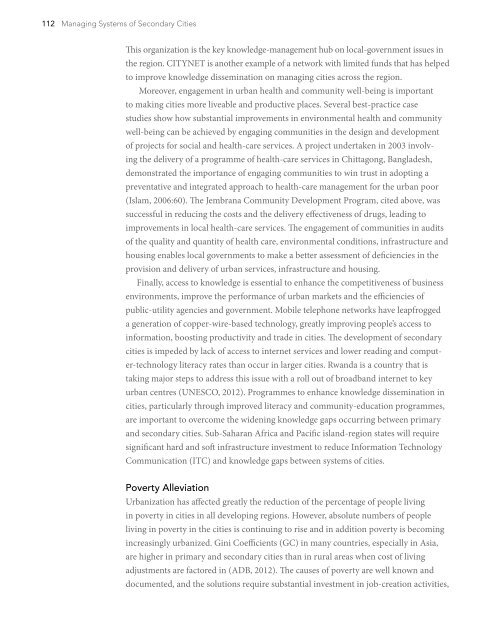DYhWN
DYhWN
DYhWN
Create successful ePaper yourself
Turn your PDF publications into a flip-book with our unique Google optimized e-Paper software.
112 Managing Systems of Secondary CitiesThis organization is the key knowledge-management hub on local-government issues inthe region. CITYNET is another example of a network with limited funds that has helpedto improve knowledge dissemination on managing cities across the region.Moreover, engagement in urban health and community well-being is importantto making cities more liveable and productive places. Several best-practice casestudies show how substantial improvements in environmental health and communitywell-being can be achieved by engaging communities in the design and developmentof projects for social and health-care services. A project undertaken in 2003 involvingthe delivery of a programme of health-care services in Chittagong, Bangladesh,demonstrated the importance of engaging communities to win trust in adopting apreventative and integrated approach to health-care management for the urban poor(Islam, 2006:60). The Jembrana Community Development Program, cited above, wassuccessful in reducing the costs and the delivery effectiveness of drugs, leading toimprovements in local health-care services. The engagement of communities in auditsof the quality and quantity of health care, environmental conditions, infrastructure andhousing enables local governments to make a better assessment of deficiencies in theprovision and delivery of urban services, infrastructure and housing.Finally, access to knowledge is essential to enhance the competitiveness of businessenvironments, improve the performance of urban markets and the efficiencies ofpublic-utility agencies and government. Mobile telephone networks have leapfroggeda generation of copper-wire-based technology, greatly improving people’s access toinformation, boosting productivity and trade in cities. The development of secondarycities is impeded by lack of access to internet services and lower reading and computer-technologyliteracy rates than occur in larger cities. Rwanda is a country that istaking major steps to address this issue with a roll out of broadband internet to keyurban centres (UNESCO, 2012). Programmes to enhance knowledge dissemination incities, particularly through improved literacy and community-education programmes,are important to overcome the widening knowledge gaps occurring between primaryand secondary cities. Sub-Saharan Africa and Pacific island-region states will requiresignificant hard and soft infrastructure investment to reduce Information TechnologyCommunication (ITC) and knowledge gaps between systems of cities.Poverty AlleviationUrbanization has affected greatly the reduction of the percentage of people livingin poverty in cities in all developing regions. However, absolute numbers of peopleliving in poverty in the cities is continuing to rise and in addition poverty is becomingincreasingly urbanized. Gini Coefficients (GC) in many countries, especially in Asia,are higher in primary and secondary cities than in rural areas when cost of livingadjustments are factored in (ADB, 2012). The causes of poverty are well known anddocumented, and the solutions require substantial investment in job-creation activities,


